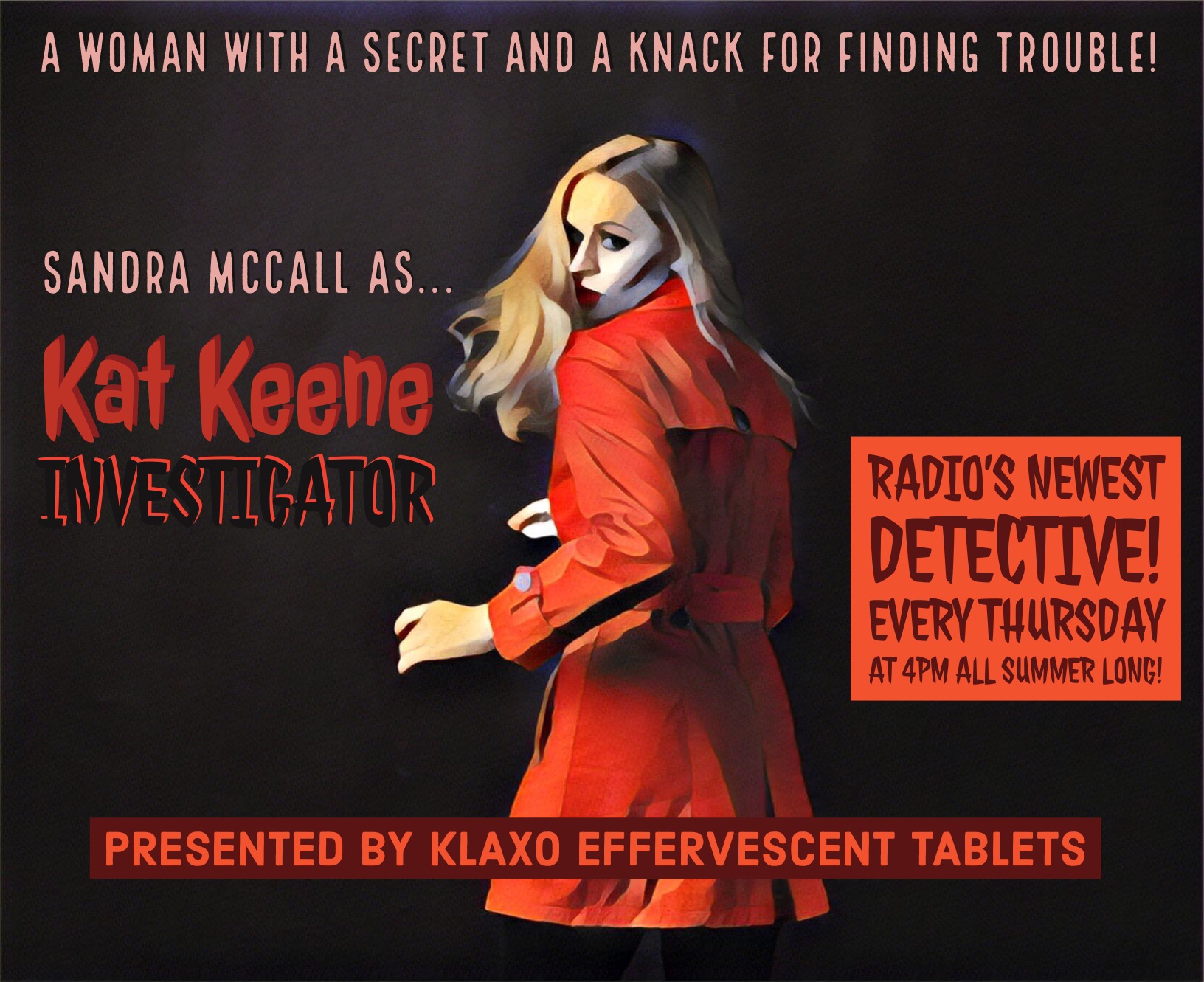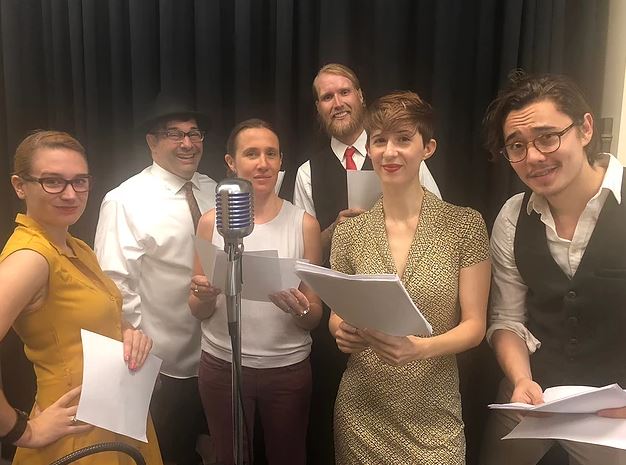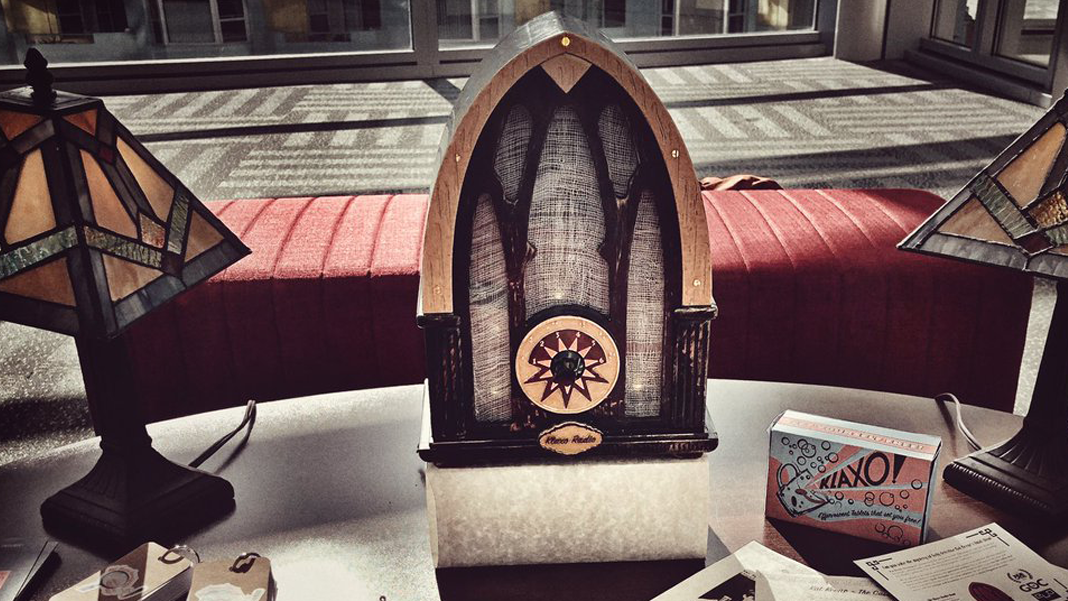I got my first look at the vintage radio at last year’s IndieCade. The game was distinct among the colorful booths, notably due to its lack of a screen. While I didn’t get a chance for a closer look, the image of it stayed with me.
Naturally, when I stumbled across it again at this year’s GDC, I knew I had to check it out. Thus began my curious experience with The Klaxo Radio Hour.
(Warning: There will be spoilers below.)

People could play The Klaxo Radio Hour in the Moscone Center’s West Hall during GDC.
On the Edge of Your Seat
I nearly missed it again. The Klaxo Radio Hour radio was set aside in a sunlit corner of one of the conference center’s floors. Well away from its fellow games at the Indie MEGABOOTH.
Its semi-isolation became clear to me as one of the developers, Martzi Campos, sat me in front of The Klaxo Radio Hour and gave a quick explanation of how the game worked. When she started it up it was quiet enough in that corner that I could really hear the radio’s audio. I quickly became engrossed as if I were listening to a podcast. Thinking about it more, podcasts owe a lot to old radio programs. It was nice seeing things come full circle.
I leaned in to get as close as possible to the radio’s narration, and to its dial, which I turned to pick story options. The whole thing reminded me of a darker version of The Thrilling Adventure Hour podcast, one that I could directly interact with.
“Just slightly more work,” Campos said with a laugh when I mentioned as much to her later.
Down the Rabbit Hole
I kept playing through the game. I couldn’t stop until I had reached the end. The vibe of a ‘40s radio mystery with its female hero and excellent sound direction had sucked me in.
Little hints and details occasionally popped up, suggesting something was off which only intrigued me further. When the eponymous Klaxo finally revealed what was really going on I was completely absorbed in the story.

As you play through the game, you realize there’s more to its promotional phrase: “Effervescent tablets that set you free!”
After I finished the game, Campos described it as a ‘40s choose-your-own-story radio adventure. As that description suggests, Campos confirmed Klaxo had multiple endings. I immediately wanted to play again and try for another ending. Sadly, I had no more time that day.
Fortunately, Campos told me a digital version of Klaxo was available online right now, and that people have even recorded playthroughs of it.
Building a Haunted Radio
“So Klaxo came about because I love Target, and I love Target’s holiday section,” Campos said. “And I was there in October, and there was this toy radio that played dumb little jingles on each of the channels.”
She had to have it. After she bought it, Campos altered it, and the ultimate result was Klaxo.
“I really love physical objects that do something unexpected or magical,” Campos said, explaining why she took a toy radio and turned it into the haunted Klaxo. It’s reminiscent of her prior work with co-designer Yuting Su on Curiouser & Curiouser, a game controlled by a physical pop-up book.

Martzi Campos altering the radio. According to a Twitter post, it was gutted and replaced with Adafruit and Arduino technology that was compatible with Unity 3D to direct the radio drama “controlled by turning the dial.”
The Roots of Radio
It was not a solo effort. Campos got in touch with another game designer, Jesse Vigil, to help her develop Klaxo. (Campos and Vigil also both work at the USC Game Innovation Lab.) Vigil brought his audio experience to the project, with Klaxo being his second audio adventure game. His first one, FREEQ, was about eavesdropping on the future.
After that first audio adventure game, Vigil said he learned from blind and low vision gamers more ways to increase the game’s accessibility. FREEQ was rebuilt to address these concerns, and this new perspective eventually led to the radio dial on Klaxo having Braille next to the numbers.
Campos also said Vigil has “a love of those old radio shows.” She added that Vigil’s knowledge of radio history included Orson Welles and his role as the original radio incarnation of the character, The Shadow.
Leading Lady
Campos wanted Klaxo to feature a female detective. However, Vigil wasn’t sure one even existed that could serve as a source of inspiration.
“We actually researched it, and we discovered Candy Matson, who was one of the few female detectives in these 1940s radio shows,” Campos said. She added that Matson’s co-partner was one of the first radio characters to be coded as gay.
Campos said they ended up designing the game based on that, “wanting to kinda honor that history.”

The game features a story-within-a-story, with Kat Keene as a detective on the radio played by the actress Sandra McCall. Sarah Elmaleh plays both Kat Keene and Sandra McCall.
Creating Vintage Sound
According to Campos, they actually started writing Klaxo during last year’s GDC. After that, they recorded over the summer. When they applied to IndieCade 2018 with a rough recording and were accepted, they continued to “beef it up.”
Vigil found the cast among people they knew and friends in the industry. Since he’d wanted to make a podcast or radio drama at some point he’d been paying attention to anyone who had “a cool sounding voice.” He said the nature of the local area helped out too.
“Because we’re in entertainment, and because we’re in LA, a lot of people are pretty good,” Vigil said. “A lot of our friends were actors at some point in their lives, or definitely involved in show biz, or had done something like this before.”
From there, Vigil said he and Campos made a list of interested and available people.
Sarah Elmaleh, who played the main character and detective Kat Keene, also supported Klaxo in other ways. (Elmaleh’s previous credits include voicing Katie in Gone Home and the Freelancer in Anthem.)
“Sarah is a friend of ours, but is also an incredible advocate for getting independent games to work with professional voice actors,” Vigil said. “So she walked us through the process of how to work with SAG so we could cast her.”
(SAG is short for SAG-AFTRA, the Screen Actors Guild – American Federation of Television and Radio Artists.)
Vigil explained that it was initially difficult to explain the Klaxo project to SAG-AFTRA, and the organization wasn’t sure if they could cover it. But eventually SAG-AFTRA identified Klaxo as “new media” and approved the project.
“Sarah was so helpful in making sure it happened,” Vigil said.
Blast From the Past
When it came to recording the audio for Klaxo, Vigil shared that they recorded it the same way people would’ve done it in the ‘40s. He said that they had the “cast clustered around a microphone, which is the descendant of the same microphone that they used at CBS and NBC for the original radio dramas.”
The cast even dressed in period clothing while they recorded.

The main cast included Sarah Elmaleh as Kat Keene, Michael Annetta as Carlton Prescott, Martzi Campos as Marjory Banks, Erin Shaver as Evelyn Drake, Patrick Quah as Charlie Gilbert, Derek Stockwell as Arthur Erikson, Jesse Vigil as the Announcer, and Collin Kelly as the Klaxo Sponsor.
Vigil added that the only thing they didn’t do was live sound effects, though he did record “a handful of new Foley” as it would’ve been done in the ‘40s. He also used vintage libraries.
“Except for the demon elements, because we wanted those to sound very different,” Vigil said. “The demons were allowed to use digital effects, to sorta let you know you’re not just listening to a vintage recording, that something’s up.”
Expanding on that, Vigil said the demons were able to be louder, and fuller, more processed, just generally more digital. He added that it served as “another anachronism” for Klaxo.
Campos shared that her favorite part of the game is to have this “cut-and-dry mystery” disrupted by having the eponymous character Klaxo break the fourth wall for the first time. She found it interesting to call out the modern day after trying to be authentically ‘40s, and to have the game “reach out and try to anchor itself in the real world.”
Increasing Broadcast Range
While there is already a digital version of Klaxo, Campos said they’re also developing it for mobile and tablet devices. Campos wants a digital version to reach more people.
“In a perfect world, I could send the radio to everyone who wants to play it,” Campos said. “Maybe the digital version will have Klaxo [the character] throw out a line or two about apps.”

The digital version of The Klaxo Radio Hour as seen on itch.io.
She would love to make a radio device for other devs to host their own choice-based audio games. The physical radio that houses and makes up the original Klaxo is off limits though.
“Klaxo lives here,” Campos said with fondness. “I can’t have anyone else live here.”



